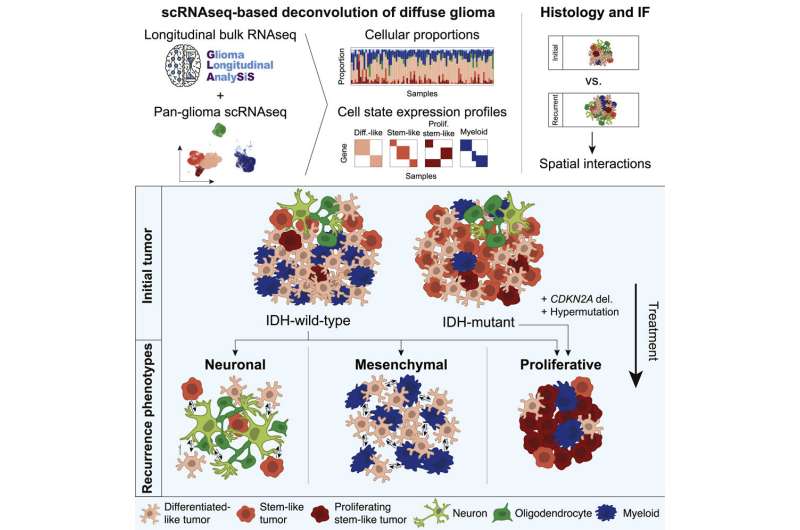Graphical abstract. Credit: Cell (2022). DOI: 10.1016/j.cell.2022.04.038
The deadliest form of brain cancer returns because tumors adapt to treatment by recruiting help from nearby healthy tissue, say researchers who are trying to find a cure for the disease.
A new study, by a global team including University of Leeds experts, has found that in response to treatment, high-grade gliomas appear to remodel the surrounding brain environment, potentially creating interactions with nearby neurons and immune cells in ways that protect the tumor cells and hide them from the body's defenses.
The team also found that lower grade tumors often develop a new mutation that allows the cells to start dividing more rapidly, potentially catapulting them into a higher-grade form.
Glioma brain tumors are rare, but a diagnosis is devastating because there is currently no cure. Low-grade gliomas have a better survival rate than, but often progress to high-grade gliomas. More than 90% of patients with high-grade tumors die within five years.
Current treatments include surgery, radiation therapy and chemotherapy. The findings indicate that new drugs are needed to supplement these.
Dr. Lucy Stead, Associate Professor of Brain Cancer Biology in the University of Leeds' School of Medicine, and the lead UK academic for the study, says that "the brain is a hugely complex organ made up of lots of different types of cells, and brain tumors are equally diverse and complicated."
"Learning from patient tissue is the best way to cure the patient disease. This study, which required a global effort to acquire enough glioma samples to adequately power it, has allowed us to gain unprecedented insight into how these deadly tumors progress, and ways that we might finally be able to stop them."
Sue, a brain tumor patient from York, died in September 2017 after a seven-year battle with the disease. Her husband of 50 years, Geoff, is now an ambassador for Yorkshire's Brain Tumor Charity, taking part in events to help raise funds for brain cancer research and awareness.
Welcoming the findings, he says that "Sue fought bravely and without a single word of complaint or self-pity for 7 years. This is my driver. The types and positions of tumors make this a difficult one to actually 'solve'. But it is a scandal that the survival rate for brain tumors is no better now than 40 years ago."
"It seems from my experience that a one size fits all approach is applied to treatment at the moment and any form of targeting treatment specifically to suit the person must be an improvement."
"The fact that research is being undertaken has also a beneficial effect for patients and their families. It generates hope."
The researchers are investigating why gliomas progress to a higher-grade form, and why they survive and continue to grow after treatment.
They collected multiple samples of gliomas over time, as they transitioned from low-to-high grade, and before and after treatment. They then looked at how the cells changed and adapted to see if they can find ways to stop them, using novel drugs.
The mutation and previously unknown cellular interactions could now be targeted with novel drugs that stop the tumor cells progressing and adapting to treatment. In this way the study has opened new avenues of research that may yield more effective drugs to offer patients.
The research was led by Jackson Laboratory (JAX) Florine Deschenes Roux Chair Professor and senior author Dr. Roel Verhaak and Postdoctoral Associate and Jane Coffins Childs fellow first author Dr. Frederick Varn.
Dr. Varn says that "by analyzing genetic and transcriptional data from this large cohort of patients, we are beginning to appreciate how tumors are changing to adapt to standard-of-care therapy."
"This study has made it clear that not every tumor changes in the same way. Knowing this is going to allow us to develop therapies that are better tailored towards each patient's disease in the future."
Dr. Verhaak says that "the GLASS project has built tremendous momentum and is just getting started."
"We are well underway to tripling our patient cohort and datasets. We are poised to comprehensively dissect the process of resistance and make important progress towards better outcomes for patients with a glioma."
The research was published in Cell.
More information: Frederick S. Varn et al, Glioma progression is shaped by genetic evolution and microenvironment interactions, Cell (2022). DOI: 10.1016/j.cell.2022.04.038
Journal information: Cell
Provided by University of Leeds























